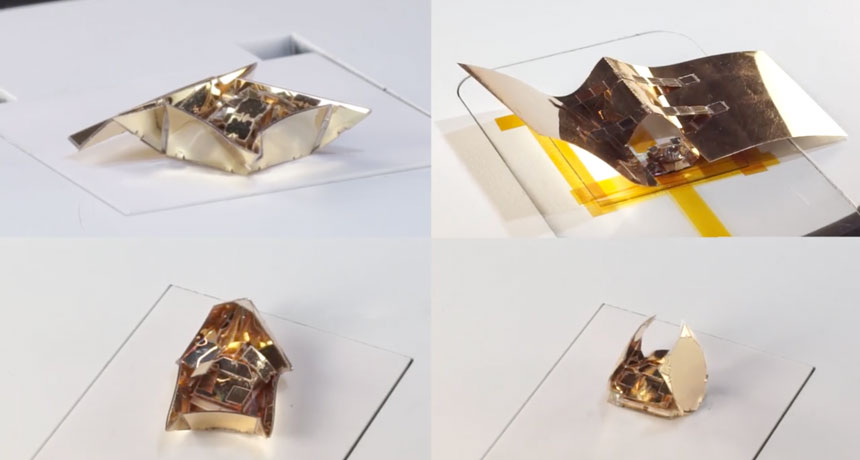These robots quickly swap ‘origami’ jackets — and tasks
Remote-controlled cubes switch outerwear to walk, roll, sail or glide

With just a quick wardrobe change, this robot can go from walking to gliding, rolling or sailing (from top left, clockwise).
MIT CSAIL
Some robotic quick-change artists are taking “dress for success” to a whole new level.
These shape-shifters can change their outer jackets in minutes. At the heart of each bot is a metal cube a few millimeters (several hundredths of an inch) across. Sheets of high-tech plastic can be tailored with cuts and heat into folded outfits that work like wings, wheels and other appendages. Depending on what outfit the bot wears, it can walk, roll or sail.
Researchers use magnetism to “drive” the little units. Such easy-to-alter machines might one day find use in everything from surgery to space exploration.
“It’s almost like putting clothes on the robot to give it different kinds of powers,” says Daniela Rus. This roboticist helped design the new prototypes. She works at the Massachusetts Institute of Technology in Cambridge. She and her colleagues unveiled them online, September 27, in Science Robotics.
Getting dressed
Key to the bots’ outfits are a material that shrinks when heated. (It’s the same kind used in oven-bake Shrinky Dink toys.) The researchers encased this material between two sheets of polyester plastic.
To get “dressed,” a bot is parked atop the layered sheeting. On each sheet, the researchers peel away some of the polyester to expose the heat-shrinking film. Later, when warmed to 65° Celsius (149° Fahrenheit), those exposed strips will contract, causing the entire sheet to fold. Indeed, they fold into some desired shape, like the paper used to make origami animals and other structures. That’s why the researchers describe their bots as donning origami outfits.
Where the polyester is removed determines into what 3-D shape a heated sheet will fold. And that shape affects what job a robot can perform. For instance, one shape turns the device into a “Walk-bot.” When steered by a magnetic field, it can now totter along.
Once an outfit folds to jacket a bot, four latches close. They fasten the plastic outerwear in place. And that jacket now serves as a functioning exoskeleton — a scaffold that gives the bot its new function. The latches are made of a water-soluble material. So wetting them allows the robot to disrobe. Now it can suit up in something new before moving on to its next task.
Future origami jackets could arm robots with drills, scissors, shovels or grippers.
Such adaptable robots may be used for surgeries free of incisions, says Antoine Cully. He is a roboticist in England at Imperial College London. He was not involved in the new work. In this kind of surgery, a patient might ingest a magnetic core and various exoskeletons. A surgeon could then remotely control, from outside a patient’s body, which outfit a bot put on. The magnets would then be directed to navigate the robot around the patient’s body. Along the way, the mini robot could snip tissue or deliver drugs to selected cells.
Shape-shifting robots also could find use in other situations. They might be especially helpful in responding to natural disasters or on space missions. Here, the bots could perform a wide range of tasks without packing lots of spare parts.







